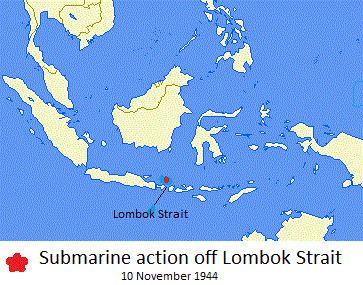Name U-537 Yard number 355 Commissioned 27 January 1943 Launched 7 November 1942 Draft 4.67 m | Ordered 10 April 1941 Laid down 10 April 1942 Construction started 10 April 1942 Length 77 m Beam 6.86 m | |
 | ||
Fate Sunk in the Java sea, 9 November 1944 Part of | ||
The German submarine U-537 was a Type IXC/40 U-boat of Nazi Germany's Kriegsmarine during World War II. Her keel was laid down on 10 April 1942 by Deutsche Werft in Hamburg. She was commissioned on 27 January 1943 with Kapitänleutnant Peter Schrewe in command. Schrewe commanded the boat for nearly two years, until her loss.
Contents
The U-537 conducted three patrols, and holds the distinction of making the only armed German landing in North America during World War II, when she installed the automatic Weather Station Kurt in Martin Bay, Labrador on 22 October 1943. She was then sent to the Far East. On 10 November 1944 in the Java Sea east of Surabaya, the U-537 was sunk with all hands — 58 officers and men — by torpedoes from the USS Flounder (SS-251).
Design
German Type IXC/40 submarines were slightly larger than the original Type IXCs. The U-537 had a displacement of 1,144 tonnes (1,126 long tons) when at the surface and 1,257 tonnes (1,237 long tons) while submerged. The U-boat had a total length of 76.76 m (251 ft 10 in), a pressure hull length of 58.75 m (192 ft 9 in), a beam of 6.86 m (22 ft 6 in), a height of 9.60 m (31 ft 6 in), and a draught of 4.67 m (15 ft 4 in). The submarine was powered by two MAN M 9 V 40/46 supercharged four-stroke, nine-cylinder diesel engines producing a total of 4,400 metric horsepower (3,240 kW; 4,340 shp) for use while surfaced, two Siemens-Schuckert 2 GU 345/34 double-acting electric motors producing a total of 1,000 shaft horsepower (1,010 PS; 750 kW) for use while submerged. She had two shafts and two 1.92 m (6 ft) propellers. The boat was capable of operating at depths of up to 230 metres (750 ft).
The submarine had a maximum surface speed of 18.3 knots (33.9 km/h; 21.1 mph) and a maximum submerged speed of 7.3 knots (13.5 km/h; 8.4 mph). When submerged, the boat could operate for 63 nautical miles (117 km; 72 mi) at 4 knots (7.4 km/h; 4.6 mph); when surfaced, she could travel 13,850 nautical miles (25,650 km; 15,940 mi) at 10 knots (19 km/h; 12 mph). The U-537 was fitted with six 53.3 cm (21 in) torpedo tubes (four fitted at the bow and two at the stern), 22 torpedoes, one 10.5 cm (4.13 in) SK C/32 naval gun, 180 rounds, and a 3.7 cm (1.5 in) as well as a 2 cm (0.79 in) anti-aircraft gun. The boat had a complement of forty-eight.
1st patrol
The U-537 left Kiel on 18 September 1943 and sailed to Bergen, Norway, departing from there on her first patrol on 30 September. She sailed across the North Atlantic, and on 22 October she set up Wetter-Funkgerät Land-26 (code-named "Kurt") automatic weather station in Martin Bay, Labrador. The weather station was only discovered by accident by the Canadian authorities in 1981.
While on anti-shipping patrol off Newfoundland on 31 October, the u-boat was attacked by a Canadian Hudson aircraft from No. 11 Squadron RCAF, which fired eight rockets, all missing. On 10 November a Canadian Catalina aircraft from No. 5 Squadron RCAF attacked her with four depth charges off Cape Race. The U-boat escaped unharmed, but the next day another Catalina of 5 Squadron attacked with four depth changes which slightly damaged the submarine. Surface ships then joined the hunt, but all failed to locate her, and the U-537 arrived safely at Lorient on 8 December.
2nd patrol
The U-537 sailed from Lorient on 25 March 1944 and traveled around Africa, and then crossed the Indian Ocean to Batavia, which she reached on 2 August after a voyage of 131 days.
3rd patrol
The U-537 left Batavia for Soerabaja on 1 October 1944, and began her third and final patrol on 9 November. On that day she was spotted and sunk with all hands — 58 officers and men — in the Java Sea, at position 7°13′S 115°17′E, by torpedoes from the USS Flounder (SS-251).
